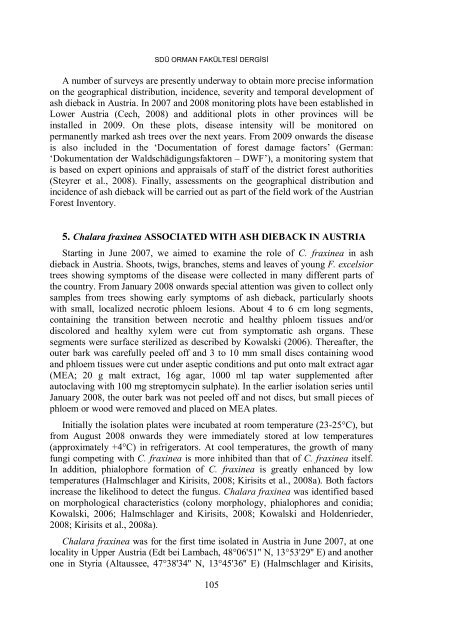sdu faculty of forestry journal special edition 2009 - Orman Fakültesi
sdu faculty of forestry journal special edition 2009 - Orman Fakültesi
sdu faculty of forestry journal special edition 2009 - Orman Fakültesi
You also want an ePaper? Increase the reach of your titles
YUMPU automatically turns print PDFs into web optimized ePapers that Google loves.
SDÜ ORMAN FAKÜLTESİ DERGİSİ<br />
A number <strong>of</strong> surveys are presently underway to obtain more precise information<br />
on the geographical distribution, incidence, severity and temporal development <strong>of</strong><br />
ash dieback in Austria. In 2007 and 2008 monitoring plots have been established in<br />
Lower Austria (Cech, 2008) and additional plots in other provinces will be<br />
installed in <strong>2009</strong>. On these plots, disease intensity will be monitored on<br />
permanently marked ash trees over the next years. From <strong>2009</strong> onwards the disease<br />
is also included in the ‘Documentation <strong>of</strong> forest damage factors’ (German:<br />
‘Dokumentation der Waldschädigungsfaktoren – DWF’), a monitoring system that<br />
is based on expert opinions and appraisals <strong>of</strong> staff <strong>of</strong> the district forest authorities<br />
(Steyrer et al., 2008). Finally, assessments on the geographical distribution and<br />
incidence <strong>of</strong> ash dieback will be carried out as part <strong>of</strong> the field work <strong>of</strong> the Austrian<br />
Forest Inventory.<br />
5. Chalara fraxinea ASSOCIATED WITH ASH DIEBACK IN AUSTRIA<br />
Starting in June 2007, we aimed to examine the role <strong>of</strong> C. fraxinea in ash<br />
dieback in Austria. Shoots, twigs, branches, stems and leaves <strong>of</strong> young F. excelsior<br />
trees showing symptoms <strong>of</strong> the disease were collected in many different parts <strong>of</strong><br />
the country. From January 2008 onwards <strong>special</strong> attention was given to collect only<br />
samples from trees showing early symptoms <strong>of</strong> ash dieback, particularly shoots<br />
with small, localized necrotic phloem lesions. About 4 to 6 cm long segments,<br />
containing the transition between necrotic and healthy phloem tissues and/or<br />
discolored and healthy xylem were cut from symptomatic ash organs. These<br />
segments were surface sterilized as described by Kowalski (2006). Thereafter, the<br />
outer bark was carefully peeled <strong>of</strong>f and 3 to 10 mm small discs containing wood<br />
and phloem tissues were cut under aseptic conditions and put onto malt extract agar<br />
(MEA; 20 g malt extract, 16g agar, 1000 ml tap water supplemented after<br />
autoclaving with 100 mg streptomycin sulphate). In the earlier isolation series until<br />
January 2008, the outer bark was not peeled <strong>of</strong>f and not discs, but small pieces <strong>of</strong><br />
phloem or wood were removed and placed on MEA plates.<br />
Initially the isolation plates were incubated at room temperature (23-25°C), but<br />
from August 2008 onwards they were immediately stored at low temperatures<br />
(approximately +4°C) in refrigerators. At cool temperatures, the growth <strong>of</strong> many<br />
fungi competing with C. fraxinea is more inhibited than that <strong>of</strong> C. fraxinea itself.<br />
In addition, phialophore formation <strong>of</strong> C. fraxinea is greatly enhanced by low<br />
temperatures (Halmschlager and Kirisits, 2008; Kirisits et al., 2008a). Both factors<br />
increase the likelihood to detect the fungus. Chalara fraxinea was identified based<br />
on morphological characteristics (colony morphology, phialophores and conidia;<br />
Kowalski, 2006; Halmschlager and Kirisits, 2008; Kowalski and Holdenrieder,<br />
2008; Kirisits et al., 2008a).<br />
Chalara fraxinea was for the first time isolated in Austria in June 2007, at one<br />
locality in Upper Austria (Edt bei Lambach, 48°06'51'' N, 13°53'29'' E) and another<br />
one in Styria (Altaussee, 47°38'34'' N, 13°45'36'' E) (Halmschlager and Kirisits,<br />
105








